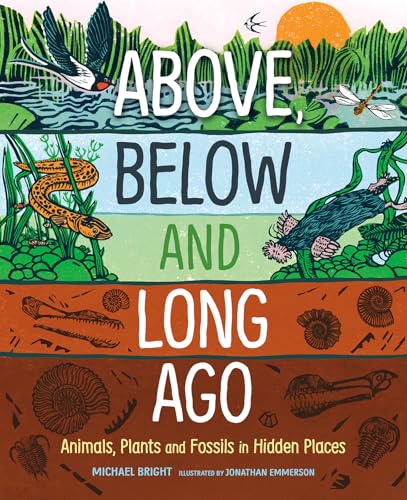Above, Below and Long Ago: Animals, Plants and Fossils in Hidden Places

Above, Below and Long Ago: Animals, Plants and Fossils in Hidden Places
Barn Swallow – Hibernating Underwater
The ancient Greek philosopher Aristotle thought they hibernated. In the United Kingdom, 18th century naturalists thought they hibernated underwater, at the bottom of ponds and lakes. It was not until December 1912, when a bird that had been fitted with an identity ring at a nest in Staffordshire, England, was found in Natal, South Africa, that naturalists realized they migrate. They go to Africa for the winter.
We’re all familiar with many animals and plants, but there are some we rarely see because of their particular habits or unusual habitats. This book’s three-part focus shows a selection of subjects found in out-of-the-way places. The general locations of the examples found world-wide are shown on a map, and a Glossary helps with scientific terms that may be new.
Each of the three sections begins with a brief introduction. “Above” is defined by high-flying birds and those that travel long distances, animals and plants adapted to living on cliffs, and those inhabiting mountainous terrain. “Below” discusses cave dwellers, life found in tunnels or beneath seas, rivers and lakes. “Long Ago” reveals stone and mineral fossils as well as ‘living fossils’, those so similar to ancient ancestors since their evolution never stopped.
Accounts presented in short paragraphs include reasons the animal or plant is seldom seen (e.g. Atlantic Puffins nesting on remote cliffs spend most of their time hunting underwater), and explains specific adaptations for the animal or plant’s success in such limited ecosystems (e.g. the Spanish Mountain Flower depends on a symbiotic relationship with ants for pollination and seed dispersal). Even more intriguing for young readers might be the section, “Below” which details lives of animals (and one plant, Western Underground Orchid) largely hidden from view except to scientists. Bats are among this group as well as an Olm (cave salamander). There’s a slim chance of seeing moles and rats even though they are often nearby since they dwell in dark places. Perhaps most amazing is the Mariana Snailfish that lives in the deepest part of the Pacific ocean.
You may have found fossil remains in rocks—ammonites, gryphaea (oysters), triliobites. But kids will also find interesting details about the survival stories of living fossils—coelacanth, horseshoe crabs, tuatara and ginkgo tree. Content links these ‘fossils’ to crucial present day functions, e.g. the horseshoe crabs that lay thousands of eggs that provide food energy for migrating sandpipers. Text is skillfully targeted to the middle reader target age: “Imagine a great white shark that’s almost twice as long as a bus, with jaws that could swallow a fully grown person whole, and teeth as big as your hand.”
These elusive examples in nature are brought to life through the colorful linocut illustrations that offer incredible texture. The time-consuming printmaking process is explained on a final page, giving readers a chance to appreciate the skill of the artist.
The selective nature of the topics and the appealing illustrations make this book unique, and one that will attract curious young readers who find science fascinating. Above, Below and Long Ago: Animals, Plants and Fossils in Hidden Places is a good starting point for them to further investigate concepts such as adaptation, migration, evolution and extinction.
Gillian Richardson is a freelance writer living in British Columbia.
